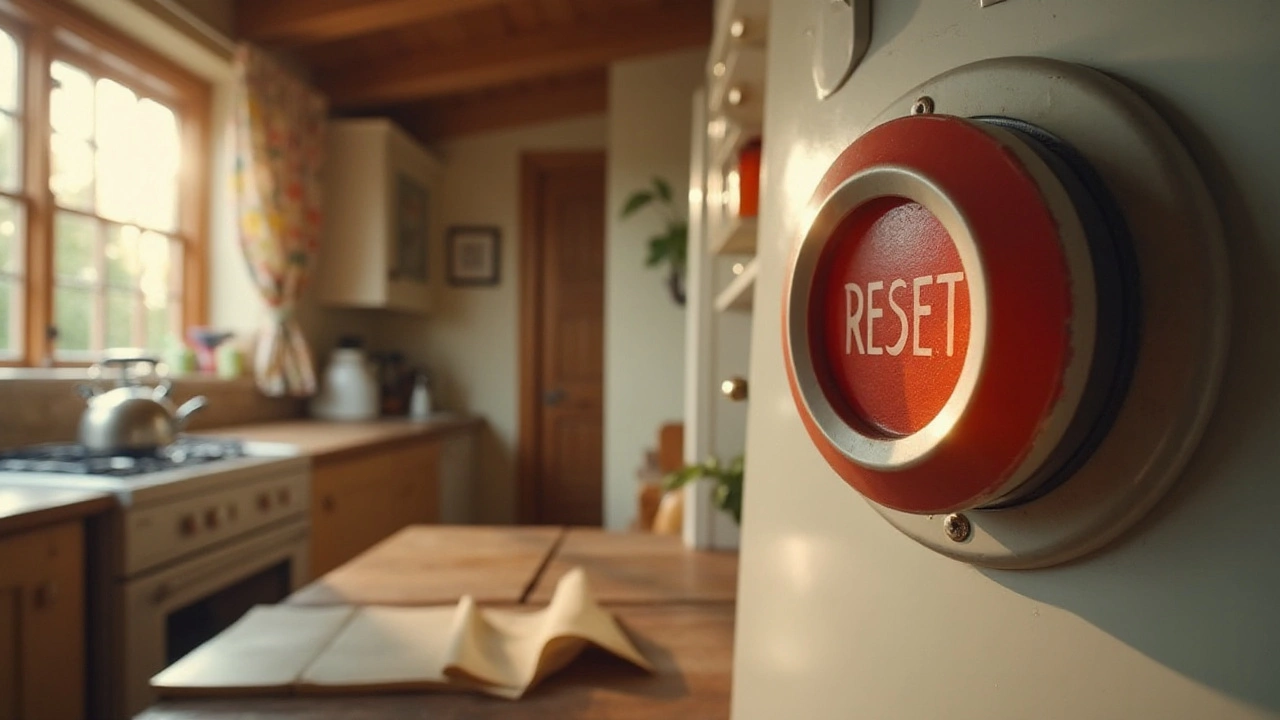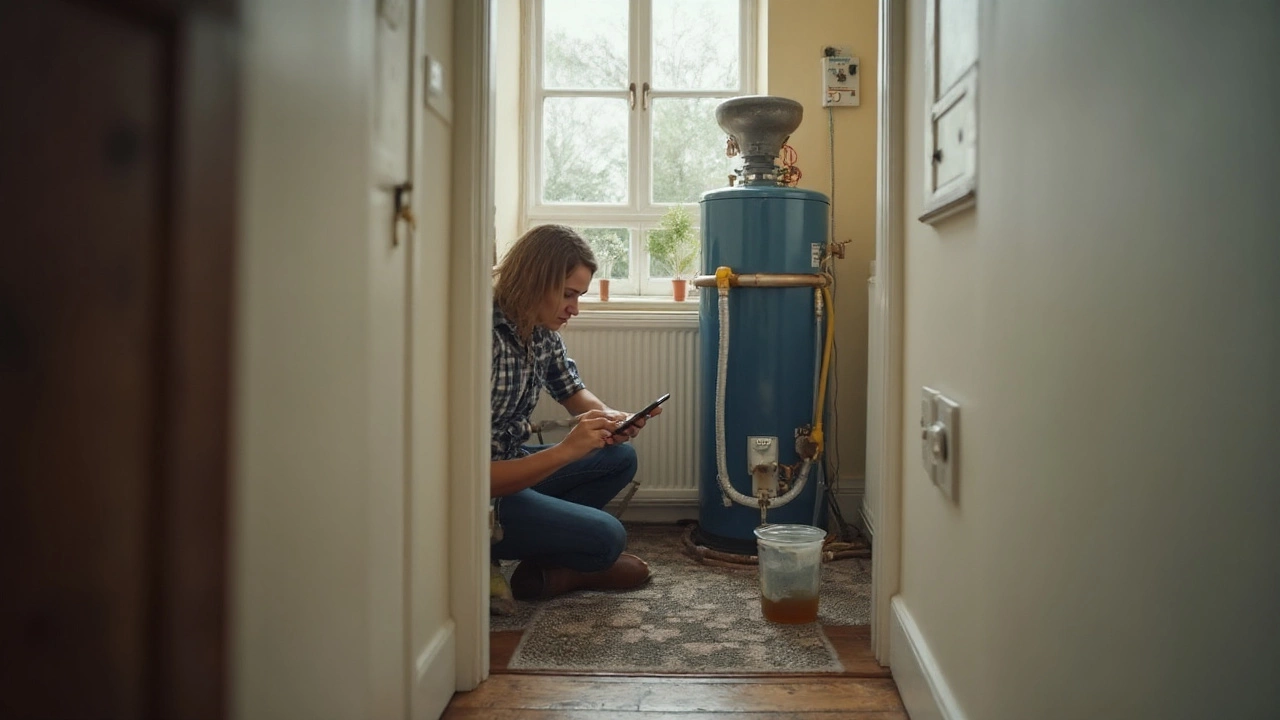
- 27 Apr 2025
- Gideon Thornton
- 0
Most people don’t even think about their water heater—until the shower turns ice cold or the tank starts groaning like it hates your guts. Truth is, flushing your water heater matters way more than you realize. It’s not just about keeping the water hot; it’s about protecting your tank from scale, rust, and downright nasty gunk that builds up over time.
If you’re wondering how often you need to flush yours, you’re not alone. Some folks flush every six months, others only when something sounds off. The truth? It depends on where you live and how you use your water. Hard water areas? The tank needs extra TLC since minerals like calcium pile up fast. Soft water? You’ve got a little more wiggle room, but don’t get lazy.
A regular flush isn't just busywork. It keeps things running quietly, cuts down on heating costs, and can even add years to your tank’s life. Plus, nobody wants lukewarm water or funny smells coming from the tap. So, if you’ve never flushed, or if you can’t remember the last time, it’s probably overdue.
- Why Flushing Your Water Heater Matters
- How Often Is Enough?
- Key Signs It’s Time for a Flush
- How to Flush Your Own Water Heater (Step by Step)
- Common Mistakes to Avoid
- Smart Habits for a Trouble-Free Water Heater
Why Flushing Your Water Heater Matters
Your water heater flush isn’t just some boring routine—it’s the secret weapon against all kinds of tank trouble. When you use hot water, minerals like calcium and magnesium separate out and start piling up at the bottom of the tank. This crusty stuff, called sediment, makes your heater work harder, cranking up your bills and wearing it out faster.
Ever noticed weird popping or rumbling from your water heater? That’s not haunted plumbing; it’s water boiling up through a layer of gunk. These noises are one of the first signs it’s time for a water heater flush. Left unchecked, sediment can cover heating elements, slow down heat-up times, and even clog up the drain valve.
- Reduces Heating Bills: Just a half-inch of sediment can spike your energy use by up to 70%. It’s like running a marathon in wet boots.
- Prevents Rust and Corrosion: Sediment traps heat, but also lets moisture hang around. That’s a perfect breeding ground for rust, which can punch holes in your tank.
- Stops Nasty Smells: Bacteria love sitting in undisturbed hot water with lots of minerals. Flushing cuts back on the “rotten egg” smell some tanks get.
- Gives Your Water Heater a Longer Life: Regular water heater maintenance means less chance of surprise leaks and breakdowns (and the angry, cold showers that come with them).
Take a look at the numbers—skipping regular tank flushing can trim years off your heater’s lifespan and send your energy bills soaring:
| Issue | Effect of Skipping Flushing |
|---|---|
| Water Heater Lifespan | Cut by up to 30% |
| Energy Bills | Increase up to 70% |
| Chance of Major Repair | Almost doubles after year 6 |
So, if you want hot water that’s clean, cheap, and always ready when you need it, flushing your water heater isn’t optional—it’s essential.
How Often Is Enough?
This is the big question: how often should you really do a water heater flush? The answer depends a lot on your water quality and how much you use hot water. Still, experts across the board agree—once a year is a solid rule of thumb for most people. That’s what most heater manufacturers say too. It’s enough to keep minerals and grit from piling up, but not so often that it feels like a chore.
But let’s get specific. If you live somewhere with hard water—meaning your water has lots of minerals—flushing every 6 months is smarter. You’ll see more white, chalky stuff piling up at the bottom of the tank, and it’s a recipe for trouble if you put it off. In places with very soft water, you might stretch it to every 18–24 months, but don’t go longer than that unless you’re cool with surprise repairs.
Here’s a quick guide you can use:
- Hard water area: Flush every 6 months
- Average water: Once per year
- Soft water: Every 18–24 months
Do you have a big family or use loads of hot water for laundry, dishes, or showers every day? Bump up the frequency—twice a year is safer. Tankless heaters need less attention, but even those can benefit from a flush once a year if your water’s mineral-heavy.
Here’s a quick look at how hard different areas’ water usually is in the U.S.:
| Region | Water Hardness Level |
|---|---|
| Midwest | High |
| Southwest | Very High |
| Northeast | Moderate |
| Pacific Northwest | Low |
Bottom line—don’t leave your water heater flush until something breaks. Yearly is the safe bet, but checking your area’s water quality can help you fine-tune it. Your heater (and your wallet) will thank you.
Key Signs It’s Time for a Flush
Your water heater flush isn’t a guessing game. The tank tells you when it’s overdue for some attention. Just pay attention to a few obvious signals—ignore them and you’re asking for trouble.
- Strange noises: If your heater rumbles, pops, or sounds like marbles clinking, it’s not haunted. That’s hardened mineral deposits bouncing around. These sounds mean the tank’s working extra hard, which can wear it out early.
- Cloudy or rusty water: When the tap spits out water that looks murky or has a reddish tint, you’re likely seeing rust or sediment that’s broken loose from the inside. Time to flush, unless you like bathing in mystery soup.
- Water takes too long to heat: If your showers go cold faster than they used to, or the water takes ages to warm up, sediment build-up is probably insulating the heating element. Flushing removes the gunk so your heater performs like it should.
- Bad smelling hot water: Sulfur or rotten egg odors usually point to bacteria thriving in the sludge at the bottom of your tank. Regular tank flushing keeps things fresh and safe.
- Frequent pilot light issues: Gas water heaters can start acting up when sediment messes with the burner. If you’re relighting the pilot more than once in a blue moon, check for build-up.
Here’s how often these warning signs actually show up, based on recent service reports:
| Signal | Reported By Users (%) |
|---|---|
| Noises/Rumbling | 54 |
| Rusty or Dirty Water | 27 |
| Slow Heating | 41 |
| Bad Odors | 23 |
| Pilot Light Issues | 19 |
If you spot even one of these, don’t wait. Grab a hose and get ready for a water heater flush or call in help. Your heater, wallet, and showers will thank you.

How to Flush Your Own Water Heater (Step by Step)
Flushing your water heater isn’t rocket science, but you do need to follow some steps to get it right and stay safe. If you skip flushing, all that grime and mineral buildup can seriously shorten your tank’s life. Here’s how to do it without wrecking something—or soaking your garage floor.
- Turn Off the Power or Gas
If you’ve got an electric water heater, switch off the breaker. With gas, turn the gas control knob to “PILOT” (or completely off if you prefer). - Let it Cool Down
Hot water can burn, fast. Let the tank sit for a couple of hours if you’ve just run the hot water. Some folks even do this first thing in the morning. - Shut Off the Cold Water Supply
There should be a valve near the top of the tank. Turning this off stops new water from flowing in while you flush. - Attach a Garden Hose
Grab a regular garden hose and hook it to the tank’s drain valve (usually near the bottom). Make sure the other end of the hose points to a safe drain, driveway, or even a bucket if you want to check for a bunch of sediment. - Open the Drain Valve
Carefully open up the drain. If nothing comes out, you might have a sediment blockage—it happens if you haven’t flushed in ages. You can open a hot water tap somewhere in the house to help air flow and speed things along. - Drain and Flush
Once most of the water has flowed out, turn the cold water supply back on for 10–30 seconds. This helps rinse leftover sediment from the bottom of the tank. Do this a couple of times if you see a lot of junk coming out—the water should run pretty clear before you’re done. - Close Things Up
Shut the drain valve. Disconnect the hose. Turn the cold water supply back on and wait for the tank to fill up. Once it’s full, open a hot water tap to let out any trapped air. - Restore Power or Gas
Flip the breaker back on or set the gas knob to “ON.” Give it about 30–60 minutes and check for leaks.
How much “gunk” you spot depends on your water type and flush frequency. A 2023 survey from a Texas plumbing company showed folks in hard water cities get four times more sediment in a year compared to those with soft water. Here’s a breakdown:
| Water Type | Average Sediment Buildup (Yearly) |
|---|---|
| Hard Water | +4 lbs |
| Soft Water | Less than 1 lb |
Always check your water heater manufacturer’s directions. A few brands have specific instructions or safety warnings. If anything seems off, or if the drain valve won’t close tight after flushing, it’s time to phone a pro. Keeping this routine once a year (or twice if you’ve got hard water) can save you from an expensive water heater repair later on.
Common Mistakes to Avoid
Honestly, flushing your water heater sounds simple, but there are some mistakes that can cost you—sometimes with a busted tank or even an accidental cold shower. Here are the big ones you really want to dodge.
- Forgetting to turn off the power or gas. Draining the water heater while it's still on is a recipe for cracked tanks. Always shut off the breaker (electric models) or set the gas to pilot/off (gas models) before you drain. Skipping this step could literally burn out the heating elements.
- Not shutting off the water supply. If you forget to turn off the cold water valve first, you’ll be fighting against pressure and potentially spraying water everywhere. Easy fix: always turn the valve off at the top of the tank before draining.
- Failing to check the water temperature. Hot water and skin don’t mix well. Let the tank cool for a couple of hours before you start, so you don't risk scalding. Trust me, no DIY project is worth a burn.
- Using the wrong drain hose. Cheap hoses or old garden hoses can burst when you try to flush out all that hot, mineral-filled water. Use a thick, sturdy hose, and make sure it’s tight before you open the drain valve.
- Not fully draining sediment. Many people open the valve, see a bit of water, and call it done. But sediment can form nearly solid chunks at the bottom of the tank, especially in homes with hard water. Run water until it flows clear, and if it doesn't, close the valve, let everything settle, and try again.
- Forgetting regular water heater maintenance. Skipping the annual flush might save you a few minutes now, but it’ll cost more later. Experts agree—flushing at least once a year lengthens your tank’s life and helps keep your water heater repair bills low.
Here’s a quick look at how often common mistakes happen, based on a survey by a major water heater manufacturer:
| Mistake | % of Homeowners (Surveyed) |
|---|---|
| Didn’t turn off power/gas | 33% |
| Used wrong hose | 22% |
| Skipped flushing for a full year | 41% |
| Didn’t drain all sediment | 29% |
It’s easy to skip steps, but taking your time can mean fewer water heater repair calls and longer stretches of worry-free hot water. Don’t turn a quick job into an expensive fix—do it once, do it right.
Smart Habits for a Trouble-Free Water Heater
Let’s cut to the chase—most water heater maintenance comes down to a few simple habits. Forgetting these can shorten your tank’s life and leave you with cold showers at the worst times. Here’s how to avoid surprise repairs and keep your heater working better for longer.
- Mark your calendar for regular flushing. Pick a month, set a reminder, and actually do it. Flushing once a year is a safe bet for most homes, but if you live with very hard water, every six months is smarter.
- Check the temperature setting. The U.S. Department of Energy recommends keeping your water heater at 120°F (49°C). Any higher and you risk scaling—and waste electricity.
- Test your pressure relief valve annually. Just pull the lever—if water spurts out, you’re good. If not, that’s a problem to fix.
- Look for leaks and rust spots. Even a tiny leak around the base or rusty connections can mean trouble. Catch it early and skip the big repair bill.
- Check the anode rod every 2-3 years. This rod is the unsung hero fighting rust inside your tank. If it’s worn down, swap it out—cheap insurance for a longer-lasting heater.
I started getting in the habit after a friend’s tank burst at 2am and turned his garage into a wading pool. Since then, I just check a few minutes every spring, usually the same weekend I swap smoke alarm batteries. It’s quick, and prevents way bigger headaches later.
| Task | How Often |
|---|---|
| Flush tank | Every 6-12 months |
| Check temp setting | Yearly |
| Test relief valve | Yearly |
| Inspect for leaks/rust | Every 3-6 months |
| Change anode rod | 2-3 years |
One more tip: If you ever leave for long trips, turn your heater to "vacation" mode. It saves energy and eases wear when no one’s using hot water.
Sticking to these easy water heater repair habits can save you money, help avoid emergencies, and keep the hot water flowing right when you need it.




